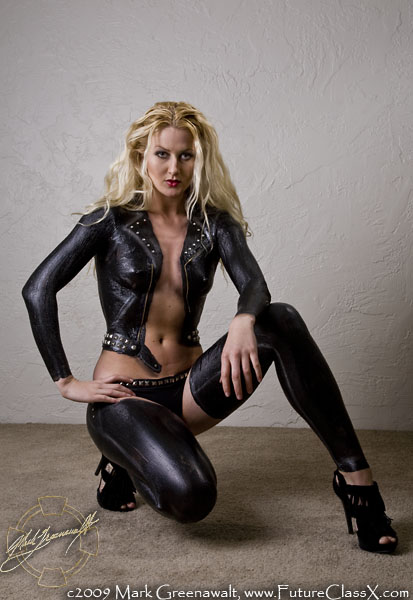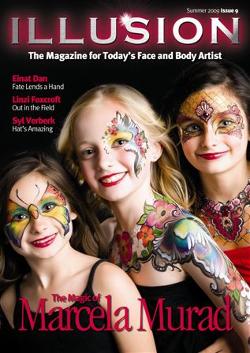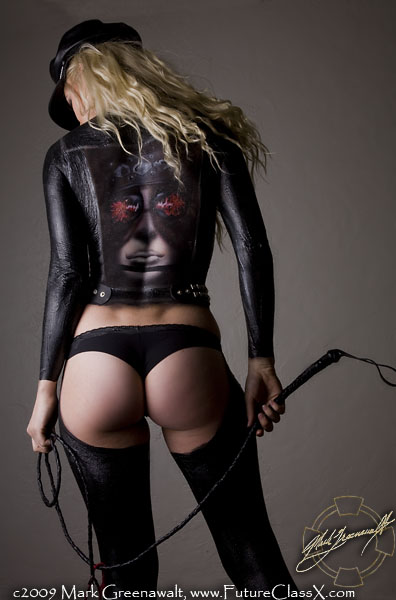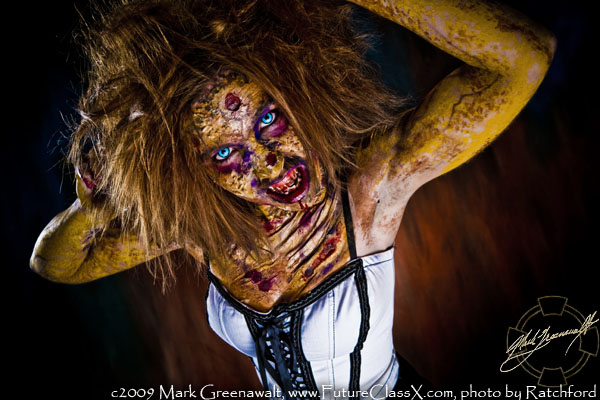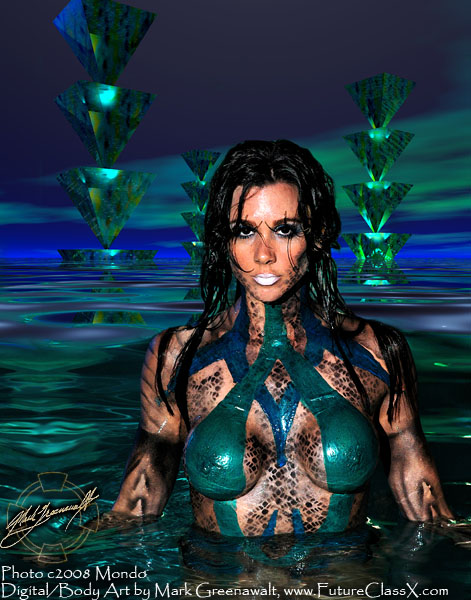FEATURESTRETCH YOUR IMAGINATION WITH LIQUID LATEXby Mark Greenawalt,ęSummer, 2009Originally published in Illusion Magazine I used liquid latex for my first body painting project. At the time I had never heard of Wolfe Brothers, Mehron, Kryolan, or any of the other bodypainting products that now flood the market. I had seen Joanne Gair's painted-on swimsuits in Sports Illustrated and Demi Moore's business suit on the cover of Vanity Fair. I had also seen Leroy Roper’s work on-line and some of Pashur’s work in a local magazine, but I couldn’t find any information about getting started as a body artist. I ended up going to an adult novelty shop and sheepishly asking if they carried body paint. They did and that’s when I bought my first jar of Maximum Impact liquid latex. When you first open a jar of liquid latex, the intense smell of ammonia is the first thing you’ll experience. I had assumed that ammonia was the solvent used for the paint, but it turns out that ammonia makes up less than 1 percent of the formula and the solvent is actually water. The ammonia keeps the latex from spoiling and controls the pH of the solution. However, ammonia can irritate the eyes. I’ve used liquid latex on my face for special effect make-up projects and getting it near the eyes can burn for a couple of seconds. I would never recommend using latex on children and even with adults I remain cautious. Besides the ammonia, liquid latex contains about one-third latex and two-thirds water. Latex is a natural ingredient that comes from rubber trees in the form of sap. There are thousands of species of trees that produce different types of latex including the Chicle tree that brings us the rubbery stuff in chewing gum. Unlike some rubber compounds, rubber tree latex is non-toxic in both its liquid and solid states, and because of this it can be found in many products such as surgical gloves, condoms, and bodypaint. Even though latex is non-toxic, some people can have an allergic reaction. The most severe of these happen immediately and are categorized as immediate hypersensitivity reaction. Fortunately I have never worked with a model who has suffered such a response, but I always ask if they have an allergy to latex. I then test a small dab of paint on their wrist and wait about five minutes before continuing. Once I got over the ammonia smell, the next thing I noticed about liquid latex was the consistency and the colour. It was as thick as house paint, somewhere between the consistency of milk and pudding. I had bought a jar of black paint, but it looked more like a chalky grey colour. I have since found this to be true with other colours; red looks pink, deep blue looks sky blue and so on. I soon found out that as the liquid latex dries it slowly transforms to the richer colours. In my case, the grey slowly turned jet black as it dried. Latex is naturally clear and dries with just a hint of amber. Manufacturers add dyes to make a wide variety of colours. Black and white are generally opaque, but the other colours tend to be a little translucent. I have experimented with adding acrylic paint into latex and stirring it until it is consistent. I was especially happy with the look of adding a metallic copper paint into a small mixture, but I am always hesitant to apply products that are not intended for use on skin. Instead I painted a base coat of black latex and once it was dry painted the copper latex over it. Once the base coat is down, it’s just like painting on rubber. I even use Createx airbrush paints on dried liquid latex for shading and texturing. The trickiest thing to get used to when using liquid latex is the tacky surface it has when it’s dry. This is what makes it stick to the skin and models will incur varying levels of discomfort as they peel the latex off (latex isn’t washed off with soap and water like most face paints). It sticks really well to body hair so there is sometimes a waxing effect that increases the discomfort. On the outer surface, this tackiness can be very challenging. For example, if a glove is painted on a hand, everything will be fine as long as the fingers are spread out. The minute one finger touches another, the latex will bond. The end result is an unfortunate tangle of latex webbing between the fingers. One latex bodysuit I painted was compromised when the model scratched her nose. The latex on her forearm stuck to the latex on her upper arm and the smooth latex sleeve became a sinewy mess. Other areas that are tricky are under the arms, inner thighs, and in some cases, under the breasts. Having said that, the tacky quality is one of the magical features of the product and there are a couple of solutions to the problem of unwanted sticking. The first is to brush metallic powders over the dried latex surface using a jumbo powder brush. The sticky surface makes the powder adhere and even black latex turns into shimmering gold, silver, or whatever metallic colour you choose. I typically use Mehron’s metallic powders, but most of the latex manufacturers have their own versions, such as Deviant’s Star Dust and Brand X’s Glymmer Effect Powder. Once the surface has been powdered, the surface tackiness is gone and the model can move freely. The second solution is to spray on a protective layer of silicon-based liquid rubber. Avoid petroleum based oils as they break down the latex. Your best bet is to buy the products associated with the brand of latex you are using such as Maximum Impact’s Ultra Shine or Deviant’s Slick Polish. These products enhance the look of latex, whether that is matte or gloss. The third solution is to rub fine glitters on the latex surface. Body artist Dawn Marie from Wisconsin creates stunning mardi-gras face masks and full body murals with base coats of latex and then vibrant designs with the glitters. Talc and baby powders reportedly work, but I have found that it dulls the look and even the neutral colour powders seem to add a white chalk-dust look to the latex. Another fun thing to do with latex is glue stuff onto it. One of my first full body liquid latex projects was painting a diving wetsuit and I included a real zipper on the front. The latex was used as the glue to apply the zipper. The basic procedure is to apply paint to the cloth on the back side of the zipper and apply paint on the model’s body where the zipper will be placed. Once both locations are tacky, stick them together. This sounds a lot easier than it is and I’ve messed up several attempts, but with some practice it gets easier. Zippers look cool on latex leather jackets too, but you can also use spirit gum to glue on silver studs, rhinestones, or even coins. Liquid latex is a fantastic product to use for special effect make-up projects like the zombie I created at Bodyssey in Toronto. For this project I used flesh coloured latex and instead of putting stuff on top of the latex, I put stuff inside instead. The torn flesh look is done by laying a small piece of tissue paper over the skin and then painting the latex over it. Once it is nearly dry, rip the center of the latex out. Another effect is to build-up scars or gashes by applying a base of latex, then laying some cotton over it while it’s still wet and lastly painting over the cotton with more latex. This gives a ghoulish three-dimensional effect. I couldn’t find any corn flakes for the rotting skin so I improvised and used some crunched up potato chips. The best way to learn how to work with liquid latex is to just start using it. Be creative and you’ll be surprised at what can be achieved. Here are the additional images and captions that were included with the article:
Mark Greenawalt |
